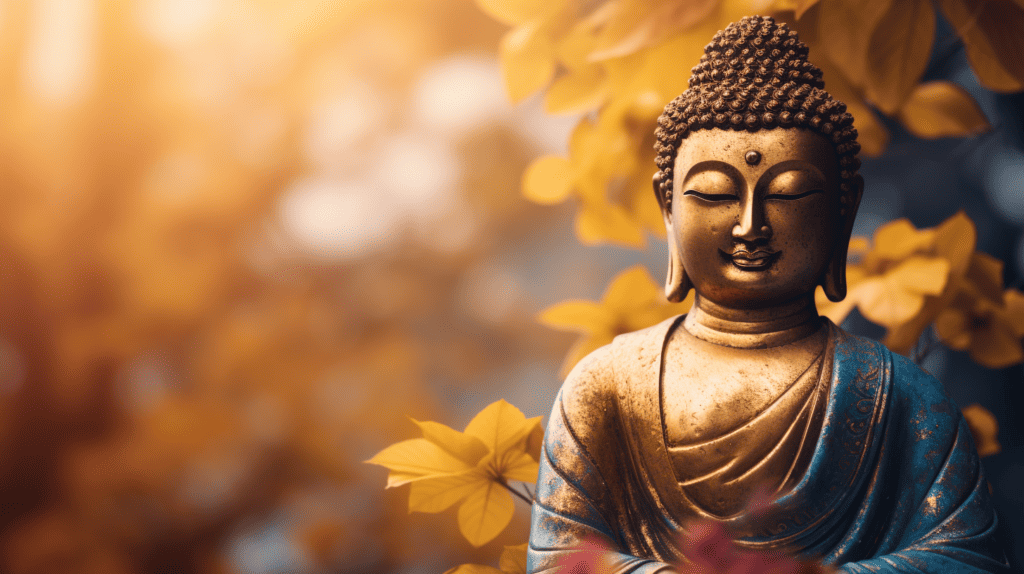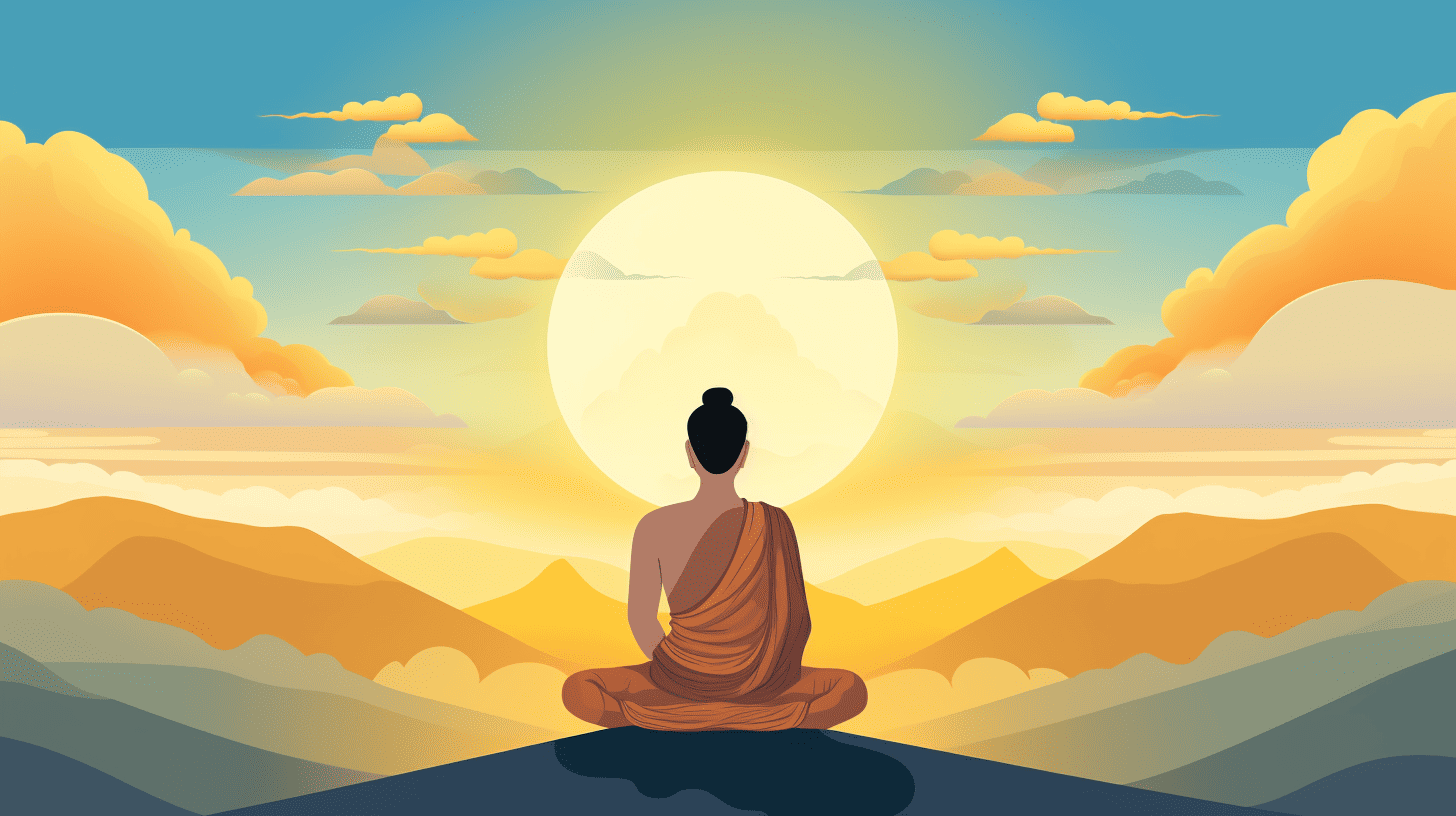As a beginner exploring Buddhism, you may have heard about mantras – short sacred syllables and words that are chanted repetitively during meditation. Mantra chanting is a common Buddhist practice that is believed to help focus the mind, invoke benevolent forces, and bring wisdom, compassion, healing and inner peace.
In this article, I will introduce you to 21 of the most popular and powerful Buddhist Mantras for Beginners used in various Buddhist traditions across Asia. Understanding the meaning and purpose behind these ancient mantras can enrich your own meditation practice.
Key Takeaways:
- Mantra chanting helps focus the mind during meditation
- Mantras invoke benevolent forces and awaken inner potential
- There are mantras for compassion, healing, long life and more
- Popular Buddhist mantras include Om Mani Padme Hum, Om Tare Tuttare Ture Soha, and Namo Amitabha Buddhaya
- Choose a mantra that resonates most and chant it regularly
- Mantra recitation can bring wisdom, compassion and bliss over time
1. Om Mani Padme Hum
Om Mani Padme Hum is perhaps the most famous Buddhist mantra. It roughly translates to “the jewel is in the lotus” or “praise to the jewel in the lotus.”
For Tibetan Buddhists, this mantra invokes the blessings of Chenrezig, the Buddha of compassion. As a beginner, by chanting this melodic mantra you can awaken the compassionate and wise Buddha nature that resides within you.
Healthy Hyena: Chanting a mantra out loud can enhance its effects. Find a quiet space where you feel comfortable vocalizing, start with a few repetitions, and focus on the meaning and vibration of the words.
Tip: Chant this mantra with an open and loving heart to evoke compassion.
2. Tadyatha Om Muni Muni Mahamunaye Svaha
Tadyatha Om Muni Muni Mahamunaye Svaha is a mantra dedicated to the historic Buddha Shakyamuni, who is believed to be the first human to attain enlightenment some 2,500 years ago in India. Shakyamuni is therefore regarded as the founder of Buddhism.
This mantra roughly means “hail to the greatly wise one, Shakyamuni Buddha – may blessings and light shine.” By chanting this mantra, Buddhists believe we can invoke the example, blessings and wisdom of this first enlightened teacher of our age.
Tip: Chant this mantra when seeking wisdom, protection or an open heart.
3. Om Tare Tuttare Ture Soha
Om Tare Tuttare Ture Soha is a mantra particularly associated with Tara, a beloved Buddhist figure revered as “the Mother of Liberation.” Tara represents the wisdom and compassionate activity of all Buddhas, and is considered the protectress and guiding light for Buddhists everywhere.
The literal translation of this mantra is “Om – Tare, swift one; Tuttare, more swift one; Ture, serenely swift one; Svaha – to the goddess Tara!” By chanting this mantra, Buddhists believe they directly receive Tara’s assistance and blessings.
Tip: Chant this mantra when seeking spiritual strength, focus or protection.
4. Om Vajrasattva Hum
In Tibetan Buddhism, Om Vajrasattva Hum is a revered purification mantra for spiritual practitioners. Vajrasattva is an enlightened Buddhist figure embodying the purity, clarity and indestructibility of a diamond (vajra).
The mantra invokes Vajrasattva’s wisdom to cut through ignorance and negativity as a sword cuts through fog. By chanting *Om Vajrasattva Hum with devotion, Tibetan Buddhists believe you can cleanse past negative karma and bring great inner peace.
Tip: Chant this mantra when seeking purification, removal of obstacles or peace of mind.
5. Namo Amitabha Buddhaya
Namo Amitabha Buddhaya is a mantra praising Amitabha, the reddish Buddha of Infinite Light, representing compassion. In Mahayana and Vajrayana Buddhism, Amitabha presides over Sukhavati, or the Western Pure Land – a paradise where souls can take rebirth through his grace.
This phrase pays homage to Amitabha: “Homage to Amitabha Buddha.” By chanting it with devotion according to tradition, Buddhists believe they will gain his blessing, purify negative karma, and achieve rebirth in his Pure Land.
Tip: Chant this mantra when seeking compassion, blessings or rebirth in Sukhavati.
6. Om Shanti Shanti Shanti
Om Shanti Shanti Shanti is a Sanskrit peace mantra popularly chanted across the Hindu and Buddhist traditions, as well as in practices like yoga and meditation. It translates simply as “Om, peace, peace, peace.”
This soothing and elegant mantra invokes harmony, calmness, peace and the highest spiritual awakening. By chanting it with care and an open heart, Buddhists believe we can heal inner pain and awaken our wise, compassionate Buddha nature.
Tip: Chant this mantra when seeking inner peace, calm and harmony with all living beings.
7. Om Dhrung Svaha
In Tibetan Buddhism, the Om Dhrung Svaha mantra invokes the blessings and protection of Ucchusma, a mythical blue-black female figure whose name means “rising lady” or “awakener”. She fiercely works against forces of delusion and negativity.
By chanting her mantra, Buddhists believe Ucchusma awakens wisdom that cuts through the darkness of ignorance like the sun dispelling night. Her blessings overcome negativity, hatred, attachment and self-centeredness, replacing them with compassion.
Tip: Chant this mantra when seeking an awakened mind, wisdom and esoteric protection.

8. Om Amarani Jiwantiye Swaha
Known as the “life-extending mantra”, Om Amarani Jiwantiye Svaha is dedicated to the long-lived Buddha Amitayus whose name means “Infinite Life.” Amitayus is celebrated for the miracle of having achieved immortality and come back to earth age after age to help living beings find liberation.
The literal meaning of this phrase is “May I have immortal life.” By chanting it, Buddhists call on Amitayus‘ spiritual guidance and aid to overcome sickness and the cycle of rebirth and death. Through his grace, the mantra awakens in the chanter a long and healthy life dedicated to enlightenment.
Tip: Chant this mantra when seeking health, healing and control over the cycle of rebirth.
9. Om Mani Peme Hung Hrih
In Tibet, Om Mani Peme Hung Hrih is a popular mantra of Avalokitesvara (the Bodhisattva Chenrezig), famed for his compassion. This longer mantra combines praises to this enlightened being along with the core heart mantra, Om Mani Padme Hum.
Buddhists in Tibet treasure this longer version as it invokes Avalokitesvara’s divine hearing. It is believed that when chanted repeatedly and with deep feeling, this mantra summons Avalokitesvara’s assistance for spiritual progress and to heal from emotional, mental and physical suffering.
Tip: Chant this mantra when seeking compassion, healing or emotional relief from suffering.
10. Om Ah Ra Pa Ca Na Dhi
Predominantly honored in Vajrayana Buddhism, Om Ah Ra Pa Ca Na Dhi is the concise heart essence mantra of the Buddha of healing and medicine, Sangye Menla or “Medicine Buddha”. Tibetan Buddhists turn to Sangye Menla in times of illness and when in need of physical, emotional or spiritual healing.
This special mantra is part of a longer one called the Medicine Buddha Mantra. According to tradition, chanting this mantra repeatedly helps pacify immediately grave physical and mental health problems, and gradually heals more deep-seated sickness caused by negativity and ignorance.
Tip: Chant this mantra whenever you seek health, healing or removal of sickness on any level.
11. Om Gate Gate Paragate Parasamgate Bodhi Svaha
Known as the “Heart Sutra Mantra”, this phrase condenses the spirit of the Perfection of Wisdom or Heart Sutra, a key Mahayana Buddhist scripture. The words essentially trace the journey to full enlightenment through stages of increasing realization.
By chanting this mantra, Buddhists believe they directly connect to the profoundly wise teachings of this sutra, bringing its message into the heart. This allows the Buddha’s timeless wisdom on emptiness, illusion and overcoming suffering to come alive through the recitation.
Tip: Chant this mantra when seeking higher wisdom beyond suffering, or teachings on emptiness.
12. Om Bekandze Bekandze Maha Bekandze Radza Samudgate Soha
In Tibetan Buddhism, Om Bekandze Bekandze Maha Bekandze Radza Samudgate Svaha is a special long life and healing mantra connected to White Tara, the female Buddha who guides practitioners to longevity. Her name means both ”the one who leads to longevity” and “the liberating one”.
By chanting this longer version of her heart essence mantra, Buddhists call on her nurturing energy to drive away sickness, harmful spirits and obstacles to health and long life. The steady recitation awakens healing forces so practitioners can continue spiritual progress in a healthy body.
Tip: Chant this mantra for healing, long life and focusing the mind.
13. Namo Ratna Trayaya
In Buddhism, the Namo Ratna Trayaya mantra pays homage to the “Three Jewels” which are the Buddha, the Dharma (his teachings) and the Sangha (the spiritual community). Known reverently as Refuges, these three gems represent enlightened body, speech and mind.
Taking refuge means giving oneself over to their guidance towards liberation. By chanting “Homage to the Three Jewels”, Buddhists plant seeds to realize this enlightened state within. They take refuge in the inner Buddha nature which is the potential for all beings to become enlightened.
Tip: Chant this mantra to give rise to wisdom, see the Buddha in all, and take refuge in your inner potential.
14. Om Muni Muni Mahamuni Shakyamuniye Svaha
Closely related to the “Shakyamuni Mantra” shared earlier, Om Muni Muni Mahamuni Shakyamuniye Svaha is another mantra praising Shakyamuni Buddha, the historical Buddha and founder of Buddhism. Shakyamuni signifies our potential to become awakened.
This longer version encapsulates “Om – Sage, Sage, Great Sage, Shakyamuni – Hail!” When chanted with devotion, this mantra invokes Shakyamuni’s blessings, wisdom, guidance and teachings so practitioners can realize enlightenment. By praising the enlightened state within, inner transformation unfolds.
Tip: Chant this mantra to invoke blessings and teachings from the historical Buddha.
15. Om Tummo Chhe Tummo Chhe Maha Tummo Chhe Bhyo Namaha
In Tibetan Buddhism, Om Tummo Chhe Tummo Chhe Maha Tummo Chhe Bhyo Namaha is a special fire mantra dedicated to the ferocious wisdom protector Vajrapani. Vajrapani wields the thunderbolt scepter symbolizing imperishable diamond wisdom that cuts through all illusions.
By chanting this mantra, Vajrapani’s wisdom blazes to incinerate delusions and negativities. His blessings guard practitioners and clear obstacles that hinder spiritual progress. Fire also represents meditational heat yogis generate to survive harsh climates.
Tip: Chant this mantra to invoke Vajrapani’s fierce protection and flame-like wisdom.
16. Om Sambhave Sambharaya Buddhaya Namahe Svaha
According to Buddhist legends, Om Sambhave Sambharaya Buddhaya Namahe Svaha is the actual mantra Siddhartha Gautama chanted the night of his great awakening as Buddha under the Bodhi tree around 500BCE. This was the pivotal moment he attained complete enlightenment after realizing the root of suffering and path to freedom.
This poetic mantra means: “Om – Salutations to the one who came to perfect wisdom and compassion and attained complete awareness: Buddha”. By chanting this, practitioners open to receive Shakyamuni Buddha’s supreme realization which spawned the entire Buddhist tradition.
Tip: Chant this mantra to invoke the Buddha’s awakening under the Bodhi tree.
17. Om Palela Palela Prasidham Kuru Svaha
As shared earlier, Amitabha is the Buddha presiding over the Pure Land called Sukhavati, where souls can take rebirth through his grace and compassion. Souls there can most easily and quickly attain liberation. Om Palela Palela Prasidham Kuru Svaha is the Tibetan Sanskrit version of Amitabha’s heart mantra.
By repeating this melodic phrase, Buddhists believe they directly receive Amitabha’s blessing which creates causes and conditions for rebirth in the Pure Land. Continued practice makes this connection so practitioners can take rebirth there after death to continue spiritual progress.
Tip: Chant this mantra to develop a heart connection with Amitabha and be reborn in his Pure Land.
18. Om Rudraya Hum Phat Svaha
In Tibetan Buddhism, Om Rudraya Hum Phat Svaha is a wrathful mantra invoking Vajrakilaya, one of the fierce Dharma Protectors who symbolize enlightened activity. As the embodiment of all Buddha’s compassionate anger towards ignorance and negativity, Vajrakilaya fiercely eliminates inner and outer obstacles hindering spiritual progress.
By passionately chanting his mantra, Buddhists believe Vajrakilaya springs into action on their behalf. His diamond wisdom energy fiercely cuts through delusions, negativity, illness and harmful forces, replacing them with rainbow light blessings.
Tip: Chant this mantra for esoteric protection and the fierce removal of obstacles.
19. Om Hayagriva Hung Phat
In Tibetan Buddhism, Om Hayagriva Hung Phat is a powerful mantra calling on Buddha Hayagriva: the wrathful horse-headed Deity of Compassion, Wisdom and Power who protects practitioners and removes obstacles. By passionately chanting his mantra, he springs into action with diamond-like wisdom to cut through all illusion and negativity.
As Hayagriva’s energy is extremely intense, monks prescribe specific retreat practices around chanting his mantra 100,000 times or more for definitive results. Buddhists believe his blessings replace harmful forces with joy, purity, compassion and all sublime qualities so practitioners gain deep spiritual purification.
Tip: Chant this mantra for intense purification of negativity and bell-like blessings.
20. Om Dhare Dhare Bhendhnamskara Svaha
In Buddhism, Om Dhare Dhare Bendhnamskara Svaha is a special mantra dedicated to the female Buddha, noble Tara, giving praise to her divine form while also invoking her healing blessings. As “the Mother of all Buddhas”, Green Tara embodies enlightened wisdom and activity.
This mantra honors her presence and sublime qualities while calling on her compassionate energy. Buddhists believe Tara’s deep healing and protective blessings can thus descend to nourish, strengthen, renew, and replenish body, heart and soul, supporting spiritual progress.
Tip: Chant this mantra to be energized and healed by Tara’s vibrant blessings.
21. Om Gam Ganapataye Namaha
Finally, Om Gam Ganapataye Namaha is a popular Hindu Sanskrit mantra praising Lord Ganesha, remover of obstacles and patron of sciences and arts. Buddhists and Hindus revere Ganesh for overcoming all obstacles, negativity, delusions and ignorance that hinder enlightenment. By chanting his mantra, his shakti energy springs into compassionate activity to clear the path ahead.
Through his blessings, instead of obstacles, practitioners enjoy great progress, abundance and sublime realizations.By praising this enlightened force, inner wisdom, compassion and creative power also flourishes.
Tip: Chant this mantra to remove obstacles and enjoy progress, abundance and creativity.
Conclusion on Buddhist Mantras for Beginners
I hope this overview has provided you insights into 21 popular Buddhist mantras for beginners! As you can see, each one has a unique origin, meaning and purpose. Finding one that resonates with you and chanting it regularly can enrich your meditation practice. Try experimenting with these to see which mantra chanting works best for your personal path ahead.
In conclusion, mantra practice helps attune us to our inner potential for enlightenment – the clear light Buddha nature inherent in all conscious beings. By chanting these sacred syllables with devotion according to tradition, we can receive blessings, heal obstacles, and gradually unfold universal compassion wisdom. May all beings tap the liberating power of mantra!
FAQ On Buddha and Mantras
Q: What does a particular mantra in buddha teachings mean?
A: A particular mantra in Buddhist teachings often encapsulates the core principles or truths of Buddhism. For example, the mantra “Om” stands for the indivisible unity of wisdom, compassion, and enlightenment.
Q: What is the significance of chanting a mantra in buddha practices?
A: Chanting a mantra plays a key role in Buddhist practices. It helps to invoke the universal sound and encourages the practitioner to channel their focus, shifting their state of mind to a more peaceful, mindful sphere. Mantras can help achieve a sense of tranquility and enlightenment.
Q: How does the Lotus Sutra relate to Nichiren Buddhism?
A: The Lotus Sutra holds a central position in Nichiren Buddhism. It is often chanted and is believed to bring forth the same Buddha nature in all who recite it. This sutra underscores the concept of Buddha nature Muni Muni and the possibility of enlightenment for all people.
Q: How can I chant the mantra to change my life according to Buddha teachings?
A: The Buddha teachings suggest that chanting of mantras can help change your life by focusing your thoughts and energies better. These syllables and words chanted repetitively provide a way to focus during meditation, helping you to gain clarity, peace, and better control your reactions, thereby gradually changing your life.
Q: What is the mantra “Om” often associated with in Buddhist teachings?
A: In Buddhist teachings, the mantra “Om” is often associated with “the mother of liberation.” It symbolizes the indivisible unity of wisdom, compassion, and enlightenment, and is often chanted to invoke these qualities.
Q: Who is the Amitabha Buddha and what is his role in Buddhist mantras?
A: Amitabha Buddha is a celestial buddha, who according to the scriptures, made a great vow to save all sentient beings. His name is a common component of various mantras and is often chanted as a mantra itself as a calling for his infinite light of wisdom and compassion.
Q: How does the chanting of mantras reflect in Buddhist teachings?
A: Chanting of mantras is a profound practice within Buddhist teachings. The mantra means “to overcome.” Through repetitive chanting, practitioners are believed to overcome the materialistic world’s temptations and distractions, centering their mind, and attaining spiritual wisdom.
Q: What mantra is connected with hail to thee in Buddha?
A: The mantra connected with ‘hail to thee’ in Buddhism is the Amithaba Buddha mantra. It is considered a veneration of the Amithaba Buddha, expressing a desire for enlightenment and a compassionate life.
Q: What role does a mantra play for beginners in Buddhist practices?
A: For beginners, a mantra provides a structured method to meditate and focus the mind. It is a way to invite peace and cultivate a positive state of mind. Chanting mantras can help beginners better understand the Buddhist teachings and principles.
Q: What are commonly chanted mantras in traditional Buddhist practices?
A: Some of the most commonly chanted mantras in traditional Buddhist practices include the mantra “Om,” which signifies indivisible unity of wisdom, compassion, and enlightenment, and the Lotus Sutra mantra, which is particularly significant within Nichiren Buddhism.





Leave a Reply